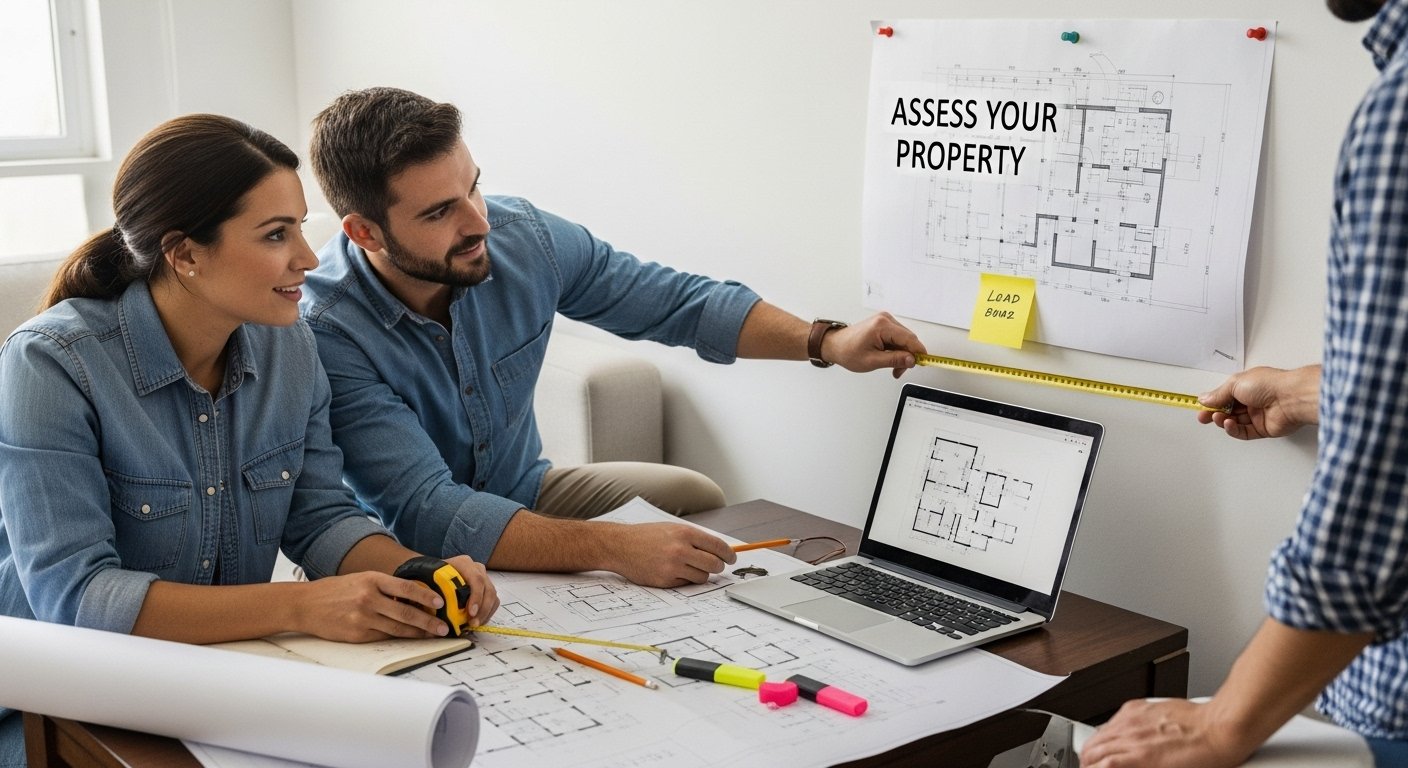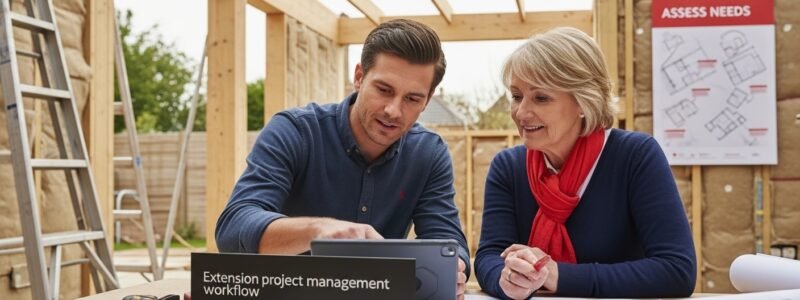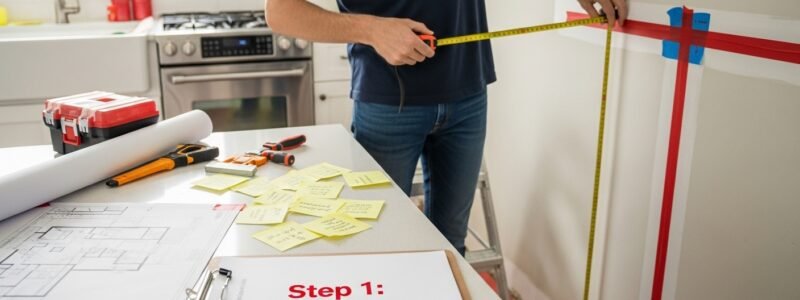Thinking about adding a double-storey extension sounds exciting and stressful in equal measure. Most homeowners are surprised to learn that almost every double-storey extension requires formal planning permission and meticulous documentation. But the real shock is how much the finer details at the very first step can make or break the whole project long before actual building starts. The cleverest projects succeed not by luck or brute force but by mastering the hidden groundwork before a single brick is laid.
Table of Contents
- Step 1: Assess Your Current Property And Needs
- Step 2: Research Local Planning Regulations And Permissions
- Step 3: Create A Detailed Design And Budget Plan
- Step 4: Hire Qualified Professionals For Construction
- Step 5: Monitor The Construction Progress And Quality
- Step 6: Finalize And Inspect The Completed Extension
Quick Summary
| Key Point | Explanation |
|---|---|
| 1. Assess your property’s needs first | Begin with a thorough evaluation of your current property and living requirements to ensure the extension meets your objectives. |
| 2. Understand local planning regulations | Research local planning permissions and requirements to avoid issues during the application process for your extension. |
| 3. Create a detailed design and budget | Develop comprehensive plans and budget allocations to ensure the project’s success and manage costs efficiently. |
| 4. Hire qualified professionals wisely | Select experienced professionals with proven records in double-storey extensions to guarantee quality work and compliance with regulations. |
| 5. Maintain oversight during construction | Regularly monitor construction progress and quality to ensure alignment with your expectations and adherence to safety standards. |
Step 1: Assess Your Current Property and Needs
Launching a double-storey extension begins with a comprehensive assessment of your current property and specific space requirements. This crucial first step determines the feasibility, potential challenges, and overall success of your home expansion project.
Start by carefully examining your existing property’s structural layout, architectural design, and available space. Measure each room meticulously, noting current dimensions, window placements, and potential connection points for the new extension. Pay special attention to load-bearing walls, existing foundations, and potential structural modifications required for seamless integration.
Consider your family’s specific needs and long-term living requirements. Are you seeking additional bedrooms, a home office, expanded living areas, or improved functionality? Understanding your precise objectives will guide the design process and ensure the extension truly enhances your living experience. Document your space requirements, desired room configurations, and anticipated lifestyle changes that this extension will accommodate.
Next, evaluate your property’s legal and regulatory constraints. Understanding the home extension planning checklist becomes essential at this stage. According to government planning guidelines, you will likely need to secure planning permission for a double-storey extension. Contact your local council to confirm specific requirements, potential restrictions, and necessary documentation.
Carefully assess your property’s external environment, including:
- Proximity to neighboring properties
- Garden space availability
- Existing landscaping and potential impact
- Natural light considerations
- Potential views to preserve or enhance
Finally, conduct a realistic budget evaluation. Consider not just construction costs, but also potential structural modifications, design fees, legal permissions, and potential unexpected expenses. A thorough initial assessment prevents costly surprises and ensures a smoother extension process, setting a solid foundation for your home improvement journey.

Step 2: Research Local Planning Regulations and Permissions
Navigating the complex landscape of planning regulations is a critical step in your double-storey extension journey. This phase involves understanding the legal framework that governs home improvements and securing the necessary permissions to transform your property legally and safely.
Local authority regulations can vary significantly between different boroughs and regions, making thorough research absolutely essential. Begin by scheduling a preliminary consultation with your local planning department. This initial meeting will provide invaluable insights into specific requirements, potential restrictions, and the documentation needed for your extension project.
Understanding the house extension approval process becomes crucial at this stage. According to government planning guidelines, most double-storey extensions will require formal planning permission. You must prepare comprehensive documentation that includes detailed architectural drawings, site plans, and a clear explanation of how the proposed extension impacts the existing property and neighborhood.
Key documentation you will need to compile includes:
- Precise architectural drawings with exact measurements
- Site location plans
- Elevation drawings showing proposed external appearance
- Detailed structural calculations
- Impact assessment on neighboring properties
Permitted development rights can sometimes offer a streamlined path, but these come with strict limitations. Your extension must comply with specific criteria regarding height, length, materials, and proximity to property boundaries. Pay close attention to these details to avoid potential rejection of your planning application.
Consider engaging a professional architectural consultant or planning advisor who understands local regulations intimately. They can help navigate potential challenges, interpret complex planning guidelines, and increase the likelihood of a successful planning application. Their expertise can prove invaluable in anticipating and addressing potential concerns before submission.
Finally, maintain meticulous records of all communications, submitted documents, and correspondence with local planning authorities. This organized approach demonstrates your commitment to compliance and can significantly smooth the approval process.
Step 3: Create a Detailed Design and Budget Plan
Transforming your double-storey extension from concept to reality requires meticulous design and financial planning. This critical stage bridges your initial vision with practical implementation, ensuring your project remains both aesthetically appealing and financially viable.
Architectural design represents the foundational element of your extension project. Begin by developing comprehensive sketches that capture your specific spatial requirements, aesthetic preferences, and functional needs. Consider engaging a professional architect who can translate your ideas into precise, buildable designs that comply with local planning regulations and maximize your available space.
Design and build planning experts recommend creating multiple design iterations to explore different layout possibilities. According to home extension cost research, strategic design can significantly impact overall project expenses. Rectangular layouts tend to be more cost-effective, while complex shapes increase construction complexity and budget requirements.
Budget planning demands ruthless precision and forward-thinking. Allocate your budget across key project components with strategic consideration:
- Construction costs (50-60% of total budget)
- Interior finishes and fittings (20-30%)
- Professional fees (10-15%)
- Contingency reserve (10-12.5%)
Incorporate potential additional expenses such as utility upgrades, landscaping restoration, and potential temporary accommodation during construction. Factor in a financial buffer of at least 10-15% to manage unexpected challenges or design modifications that may emerge during the project.
Carefully document every aspect of your design and budget plan. This comprehensive approach provides clarity, helps manage expectations, and serves as a crucial reference point throughout the extension process. Professional quantity surveyors can offer detailed cost assessments, helping you refine your budget and identify potential cost-saving opportunities without compromising structural integrity or design quality.
Remember that your design and budget plan is a living document. Remain flexible and prepared to make informed adjustments as the project progresses, always maintaining alignment with your original vision and financial constraints.
Step 4: Hire Qualified Professionals for Construction
Hiring the right professionals transforms your double-storey extension from a concept into a tangible, high-quality reality. This crucial step requires careful selection, thorough vetting, and strategic collaboration with experts who can bring your architectural vision to life while ensuring structural integrity and regulatory compliance.
Build a Recruitment Strategy
Start by developing a structured recruitment strategy. Avoid focusing solely on cost comparisons, as the cheapest option often leads to compromises in quality or project delays. Instead, evaluate potential professionals based on their expertise, reliability, and history with similar projects.
Seek recommendations from trusted sources such as architects, property developers, or friends who have recently completed extensions. In addition, industry associations and professional networks can help identify contractors with proven track records in double-storey builds.
Architectural and construction professionals recommend developing a robust selection process. According to local government workforce reports, identifying professionals with demonstrable expertise and current building regulation knowledge is paramount.
Identify the Key Professionals
A double-storey extension requires input from several specialist professionals. The core team you should consider includes:
- Chartered architect specializing in residential extensions
- Structural engineer
- Quantity surveyor
- Main building contractor
- Building control inspector
Conduct comprehensive interviews and request detailed portfolios from potential professionals. Examine their previous projects, verify professional certifications, and request comprehensive references. Pay particular attention to contractors with specific experience in double-storey extensions within your local area, as they will understand regional building regulations and architectural nuances.
Below is a table outlining the key professionals required for a double-storey extension, their roles, and the main responsibilities each one carries during the construction process.
| Professional | Main Role | Key Responsibilities |
|---|---|---|
| Chartered architect | Design and planning | Create extension designs, ensure compliance with laws |
| Structural engineer | Structural safety and calculations | Assess and advise on building support and modifications |
| Quantity surveyor | Cost and budget management | Prepare cost estimates, help manage project spending |
| Main building contractor | Construction management | Oversee on-site build, schedule work, coordinate teams |
| Building control inspector | Regulatory compliance | Inspect work stages, approve work meets regulations |
Ensure every professional you hire provides comprehensive documentation, including proof of professional indemnity insurance, detailed work contracts, and clear cost breakdowns. Request a project timeline that outlines key milestones, potential challenges, and expected completion dates. A transparent, well-documented agreement protects both you and the professionals involved.
Establish clear communication channels from the outset. Regular project meetings, detailed progress reports, and open dialogue will help manage expectations and quickly address any unexpected challenges. Remember that successful construction depends not just on individual expertise, but on seamless collaboration between all professionals involved in your extension project.
Step 5: Monitor the Construction Progress and Quality
Construction monitoring represents the critical phase where your meticulously planned double-storey extension transforms from architectural drawings into physical reality. This step demands vigilant oversight, strategic engagement, and proactive quality management to ensure your project meets both your expectations and stringent building standards.
Establish a robust communication framework with your construction team from the project’s outset. Schedule regular weekly site meetings to review progress, discuss potential challenges, and maintain transparent dialogue. These meetings provide an opportunity to track milestone achievements, address emerging issues promptly, and ensure alignment with your original design and budget parameters.
Construction project monitoring requires a systematic approach to quality control. According to government construction safety guidelines, comprehensive monitoring helps identify and mitigate potential structural or regulatory risks before they escalate into costly problems.
Key monitoring checkpoints during your double-storey extension include:
- Foundation and structural integrity verification
- Compliance with approved architectural plans
- Building regulation and planning permission adherence
- Materials quality and specification confirmation
- Electrical and plumbing system installations
Document every stage of the construction process meticulously. Take regular photographs, maintain a detailed project journal, and request comprehensive progress reports from your contractors. These records serve multiple purposes: tracking development, providing evidence of work completed, and creating a valuable reference for future maintenance or potential property valuations.
Remain personally involved without micromanaging. While professional contractors are experts, your informed oversight ensures the project remains true to your vision. Request explanations for any deviations from the original plan, and insist on written justifications for significant changes. Professional contractors should welcome your engaged, collaborative approach.
Finally, conduct thorough inspections at each critical construction stage. This includes foundation laying, structural framing, roofing, and interior finishing. Your keen eye and systematic approach will help maintain the highest quality standards throughout the extension project.

Step 6: Finalize and Inspect the Completed Extension
The culmination of your double-storey extension project arrives with the final inspection and completion phase. At this stage, meticulous attention to detail transforms your architectural vision into a fully realised living space. It also ensures every aspect of the construction meets your expectations, complies with building regulations, and upholds professional standards.
Carry Out a Thorough Walkthrough
Begin with a comprehensive personal walkthrough of the completed extension, systematically examining each element against your original design specifications. Check every structural junction, surface finish, and functional detail with a critical eye. Lighting, electrical outlets, heating integration, and structural connections demand particular scrutiny. Note any discrepancies or areas requiring adjustment, no matter how minor they might seem.
The following table presents a checklist of critical inspection criteria you should verify during the final phase of your double-storey extension project to ensure everything meets regulatory and quality requirements.
Use a Completion Checklist
The final phase should also include a structured inspection process. Using a checklist ensures nothing is overlooked and helps you keep the project aligned with both regulatory and quality standards.
| Inspection Criteria | What to Check For | Why It Matters |
|---|---|---|
| Structural integrity | Soundness of joins and framework | Ensures overall building safety |
| Thermal insulation performance | Adequate insulation fitted throughout | Provides comfort and energy efficiency |
| Electrical/plumbing functionality | All systems function as designed | Addresses functionality and safety requirements |
| Fire safety compliance | Fire exits, alarms, materials as required | Meets legal and household safety standards |
| Sound and moisture proofing | Noise barriers and leak prevention | Prevents future issues and preserves integrity |
| Finish quality/aesthetic alignment | Smooth finishes, design matches plans | Achieves your intended visual and functional goals |
Understanding the extension timeline becomes crucial in this concluding phase. According to local building control guidelines, a formal inspection is essential to validate the project’s compliance with approved plans and building regulations.
Critical inspection points include:
- Structural integrity verification
- Thermal insulation performance
- Electrical and plumbing system functionality
- Fire safety compliance
- Sound and moisture proofing
- Finish quality and aesthetic alignment
Engage your contracted professionals for a formal snagging inspection. This professional assessment identifies any outstanding issues, from minor cosmetic imperfections to potential structural concerns. Request a comprehensive written report detailing findings and recommended rectifications. Ensure all identified problems are addressed promptly and to your complete satisfaction before making final payments.
Obtain and carefully preserve all necessary documentation, including building regulation completion certificates, warranties for materials and workmanship, and updated property documentation. These documents are crucial for future property valuations, potential sales, and insurance purposes.
Finally, celebrate your successful extension project. Your commitment to detailed planning, professional collaboration, and rigorous quality control has transformed your property, creating a beautiful, functional new living space that reflects your vision and enhances your home’s value.
Seamless Double-Storey Extensions Without the Stress
Expanding your home with a double-storey extension is an exciting journey, but it can quickly become overwhelming. Challenges such as complex planning permissions, unpredictable budget changes, and finding reliable professionals often stand in the way of your vision. Many homeowners want to maximise their space and add real value without risking legal pitfalls or project delays. This article has walked you through each technical and practical detail, from assessing your needs to carrying out final inspections.
Reltic Extend specialises in solving these problems for you. Our team manages every aspect, including planning and permissions and project management, using more than 20 years of experience to simplify every step. We offer clear, stage-by-stage pricing and a 10-year structural warranty for complete peace of mind. Start your own home transformation today. Reach out via our contact page and see how easy it can be to bring your double-storey extension plans to life. Now is the best time to create a more spacious and valuable home in London or Surrey.
Frequently Asked Questions
What is the first step in planning a double-storey extension?
The first step is to assess your current property and specific space needs. This includes examining the structural layout, measuring room dimensions, and understanding your long-term living requirements.
Do I need planning permission for a double-storey extension?
Yes, most double-storey extensions require formal planning permission. It’s essential to consult your local planning department for specific regulations and documentation needed for your project.
How should I create a budget for my double-storey extension?
Your budget should allocate costs across construction, interior finishes, professional fees, and a contingency reserve for unexpected expenses. Aim for a detailed cost breakdown to manage your financial expectations.
What professionals should I hire for my extension project?
Key professionals to hire include a chartered architect, structural engineer, quantity surveyor, main building contractor, and a building control inspector. Engaging experienced professionals ensures compliance with regulations and quality construction.





